Moncler Bundle
How Does Moncler Conquer the Luxury Outerwear Market?
The luxury fashion industry is a battlefield, and Moncler, with its iconic down jackets, is a key player. LVMH's recent investment hints at the brand's enduring appeal and strategic importance. But in a market saturated with high-end apparel brands, how does Moncler maintain its competitive edge?
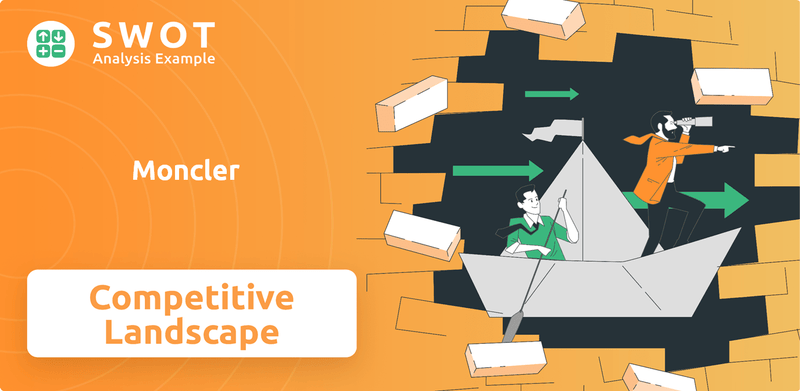
This article delves into the Moncler SWOT Analysis, providing a comprehensive Moncler market analysis to understand its position within the down jacket market and broader luxury fashion industry. We'll explore Moncler's main rivals, dissect its brand positioning strategy, and examine the competitive advantages that fuel its financial performance. Prepare for an in-depth look at the future of Moncler's competitive landscape, including its marketing strategies and how it differentiates itself from competitors.
Where Does Moncler’ Stand in the Current Market?
Moncler's strong market position in the luxury outerwear sector is a result of its unique blend of performance and high-end style. The Moncler Group, including both Moncler and Stone Island, reported consolidated revenues of €3,108.9 million in 2024. The Moncler brand itself contributed €2,707.3 million to this revenue, demonstrating significant financial health and market strength.
The company's core operations revolve around its down-filled outerwear, sportswear, and ready-to-wear collections, expanding into various categories like vests, raincoats, and accessories. Moncler's value proposition lies in its ability to offer products that combine functionality with luxury, appealing to a diverse customer base. This approach has allowed Moncler to maintain a solid position within the competitive luxury fashion industry.
Moncler's success is further highlighted by its robust financial performance. The group's EBIT reached €916.3 million in 2024, with a solid 29.5% margin on revenues. The direct-to-consumer (DTC) channel is a key driver of profitability, accounting for 87% of Moncler brand revenue in Q1 2025. This strategic focus on DTC sales has significantly boosted its market position and profitability.
The Moncler Group's consolidated revenues increased by 7% at constant exchange rates in 2024. The Moncler brand saw an 8% increase in revenue at constant exchange rates. This growth indicates strong consumer demand and effective market strategies.
Asia remains the most significant region, with the Moncler brand generating €1,379.0 million in revenue in 2024. The EMEA region recorded revenues of €949.3 million. The Americas increased by 4% at constant exchange rates to €379.0 million.
Moncler operates through direct retail and wholesale channels. As of December 31, 2024, the Moncler brand had 286 directly operated stores (DOS). The DTC channel is a key driver of profitability, accounting for 87% of Moncler brand revenue in Q1 2025.
Moncler targets a diverse customer base, including Gen Z and millennials. The brand uses distinctive product lines like Moncler Genius, Moncler Collection, and Moncler Grenoble. This segmentation allows Moncler to cater to different age groups and preferences.
Moncler's competitive advantages include its strong brand reputation, innovative product design, and effective distribution channels. The company's focus on the DTC model has significantly improved profitability. This strategy allows Moncler to maintain control over the customer experience and brand image.
- Strong brand recognition and customer loyalty.
- Effective DTC strategy driving profitability.
- Expansion into new markets, particularly in the US.
- Diverse product lines catering to various customer segments.
Moncler SWOT Analysis
- Complete SWOT Breakdown
- Fully Customizable
- Editable in Excel & Word
- Professional Formatting
- Investor-Ready Format
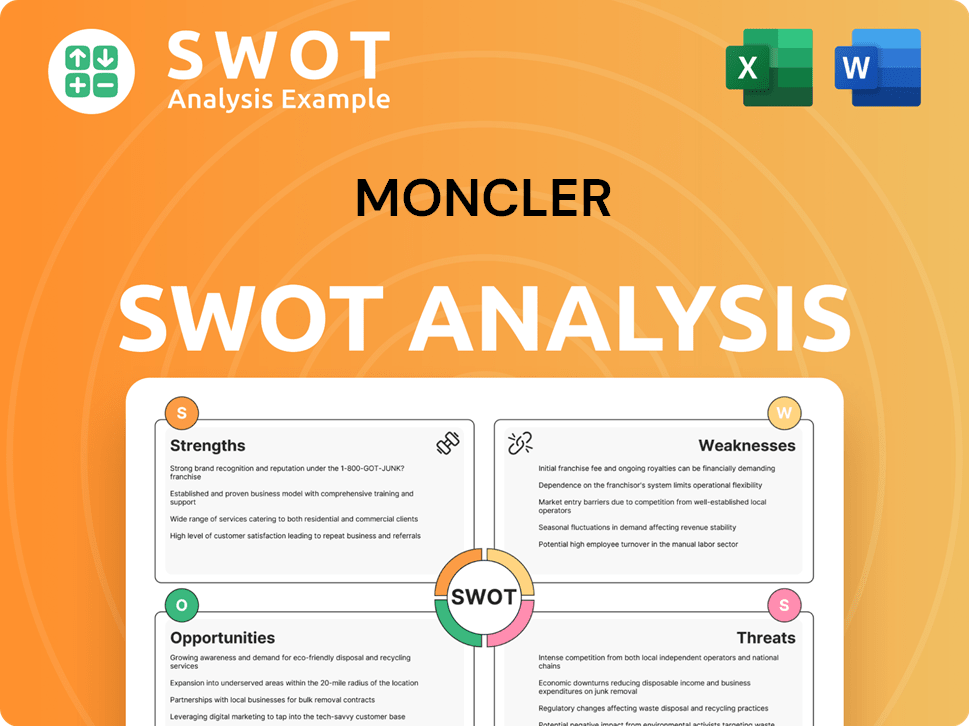
Who Are the Main Competitors Challenging Moncler?
The Moncler competitive landscape is defined by its position within the luxury fashion industry, particularly the high-end apparel and down jacket market. This landscape includes both direct and indirect competitors, each vying for market share and consumer attention. Understanding these competitors is crucial for assessing Moncler's market position and future growth potential.
Moncler's market analysis reveals a complex interplay of established luxury brands and niche players. The competitive environment is dynamic, with companies constantly innovating in design, marketing, and distribution to maintain their competitive edge. This section provides a comprehensive overview of Moncler's key competitors, their strategies, and their impact on Moncler's performance.
Moncler operates in a highly competitive environment. The luxury fashion industry is characterized by intense competition, with brands constantly striving to differentiate themselves through product innovation, branding, and customer experience. The down jacket market, where Moncler is a key player, is also competitive, with several brands offering similar products. This section examines the key players in Moncler's competitive landscape.
Major luxury conglomerates, such as Kering, Prada, Burberry, LVMH, Christian Dior, and Hermès, pose significant competition. These companies offer a wide range of products, including outerwear, which directly competes with Moncler's offerings.
More direct competitors in the performance-oriented luxury outerwear niche include Canada Goose, Perfect Moment, Halfdays, Fusalp, and Save the Duck. These brands focus on similar product categories, competing for the same customer base.
Moncler's competitive performance as of July 2021, indicated a moderate level of competition within the industry. High-profile 'battles' often manifest in areas of innovation, branding, and direct-to-consumer strategies.
Moncler's strong performance in China, with double-digit growth in 2024, stands out, as some competitors have struggled in that market. This highlights the importance of geographical diversification and market-specific strategies.
New and emerging players, particularly those focusing on sustainable materials or niche outdoor segments, could also disrupt the traditional competitive landscape. These companies often target specific consumer preferences and trends.
Key competitive factors include product innovation, brand reputation, distribution network, pricing strategy, and marketing effectiveness. Companies that excel in these areas are better positioned to succeed.
Moncler differentiates itself through its brand positioning, product design, and distribution channels. The company's focus on high-quality materials, innovative designs, and collaborations with renowned designers enhances its brand image and appeal. Moncler's marketing strategies emphasize its luxury positioning and lifestyle branding.
- Brand Positioning: Moncler has successfully positioned itself as a luxury brand, commanding premium prices and attracting a discerning customer base.
- Product Innovation: The company continuously innovates in product design and materials, offering unique and high-performance outerwear.
- Distribution Network: Moncler's distribution network includes a mix of directly operated stores, wholesale partnerships, and online channels, ensuring broad market reach.
- Marketing and Branding: Moncler's marketing efforts focus on creating a strong brand image and lifestyle appeal, often collaborating with artists and designers.
- Sustainability Initiatives: Moncler is increasingly focusing on sustainability, which enhances its brand image and appeals to environmentally conscious consumers.
Moncler PESTLE Analysis
- Covers All 6 PESTLE Categories
- No Research Needed – Save Hours of Work
- Built by Experts, Trusted by Consultants
- Instant Download, Ready to Use
- 100% Editable, Fully Customizable
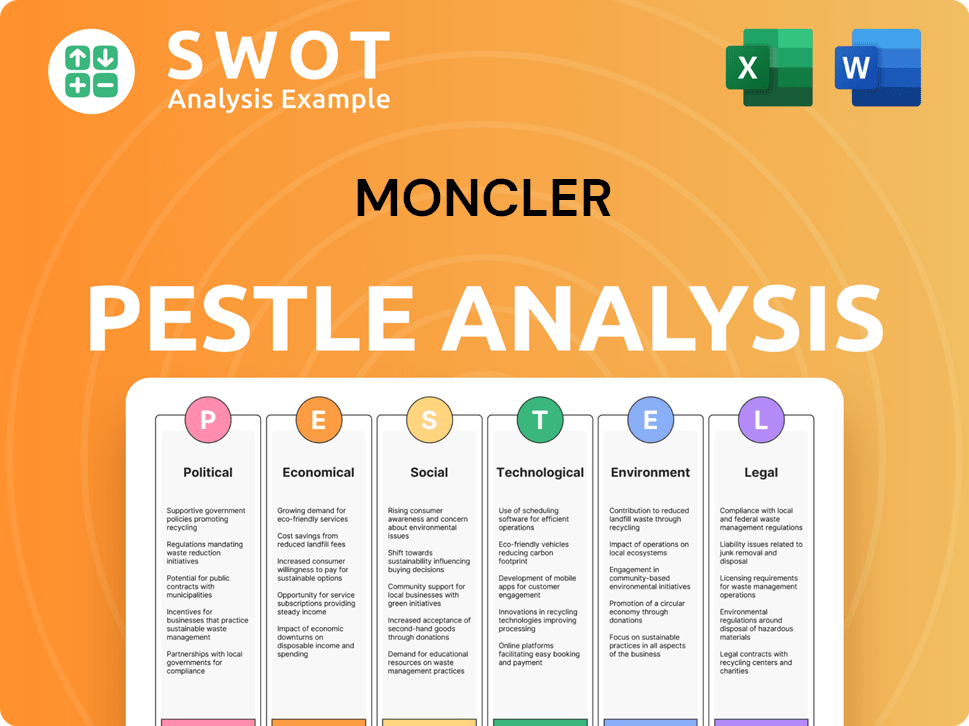
What Gives Moncler a Competitive Edge Over Its Rivals?
The competitive advantages of Moncler stem from its strong brand recognition, innovative product development, robust direct-to-consumer (DTC) strategy, and commitment to sustainability. These elements, combined with a focus on luxury and technical expertise, have established a unique position in the luxury fashion industry. A deep dive into the Growth Strategy of Moncler reveals the company's strategic moves and how it maintains its competitive edge.
Moncler's ability to blend its heritage with contemporary urban style is a key differentiator. The brand's recognizable designs and logos, along with its association with alpine elegance and premium craftsmanship, contribute to a high level of brand awareness and customer loyalty. Moncler's focus on innovation, such as the Moncler Genius project, and its control over distribution channels, especially DTC, further solidify its market position. The company's financial performance compared to competitors is also a key factor.
Moncler's commitment to sustainability enhances its competitive standing. The company's 2020-2025 Sustainability Plan focuses on climate change, circular economy, responsible sourcing, diversity, and community support. These initiatives not only appeal to environmentally conscious consumers but also enhance the brand's reputation in the competitive landscape.
Moncler's strong brand equity is a primary competitive advantage. Its recognizable designs and logos, along with its association with alpine elegance and premium craftsmanship, contribute to a high level of brand awareness and customer loyalty. The company's motto, 'born in the mountains, living in the city,' encapsulates its ability to blend heritage with contemporary urban style.
Innovation is a continuous driver for Moncler. The Moncler Genius project, launched in 2018, fosters collaborations with diverse designers to create limited-edition collections. These collaborations generate significant buzz and maintain brand exclusivity. The company also invests in research and development to automate production processes and improve product quality.
Moncler's strong control over its distribution, particularly its dominant DTC channel, is a significant advantage. This channel accounted for 87% of Moncler brand revenue in Q1 2025. This allows the company to control pricing, brand experience, and customer data, contrasting with peers more reliant on wholesale partners.
Moncler's commitment to sustainability enhances its competitive standing. The company's 2020-2025 Sustainability Plan focuses on climate change, circular economy, and responsible sourcing. In 2024, over 43% of yarns and fabrics used in its collections were lower impact, and over 55% of total nylon scrap from outerwear production was recycled.
Moncler's competitive advantages are multifaceted, including strong brand equity, innovative product development, a robust DTC strategy, and a commitment to sustainability. These factors contribute to the company's ability to differentiate itself in the luxury fashion industry and the down jacket market. Moncler's market share analysis and brand positioning strategy are key to its success.
- Strong Brand Recognition: High brand awareness and customer loyalty due to recognizable designs and association with alpine elegance.
- Innovation: The Moncler Genius project and investments in R&D drive product differentiation and exclusivity.
- DTC Dominance: Control over distribution channels, allowing for better pricing, brand experience, and customer data management.
- Sustainability: Initiatives to reduce environmental impact, appealing to environmentally conscious consumers.
Moncler Business Model Canvas
- Complete 9-Block Business Model Canvas
- Effortlessly Communicate Your Business Strategy
- Investor-Ready BMC Format
- 100% Editable and Customizable
- Clear and Structured Layout
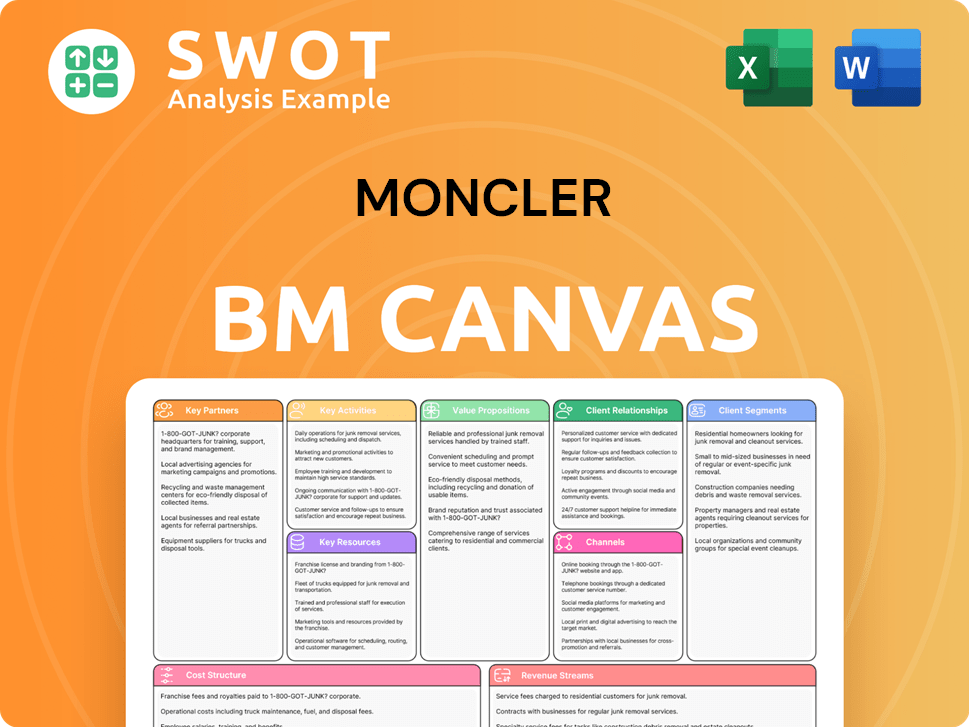
What Industry Trends Are Reshaping Moncler’s Competitive Landscape?
The luxury fashion industry is dynamic, driven by technological advancements, shifting consumer preferences, and a growing emphasis on sustainability. Understanding the Moncler competitive landscape involves analyzing its adaptation to these trends. As of 2024, the company continues to navigate challenges and seize opportunities within a volatile global market, aiming to maintain its strong market position.
Moncler's market analysis reveals a brand strategically aligning with these trends. The company is investing in digital innovation and e-commerce while focusing on sustainability initiatives. However, it faces challenges like macroeconomic volatility and intense competition. The company's ability to innovate and adapt is critical to its long-term success.
Moncler is investing in digital innovation and e-commerce to capitalize on the growing importance of online shopping. The company's 'smart factory' in Trebaseleghe, Italy, enhanced in 2024, uses a filtering system to optimize processing scraps and allow for the reuse of scattered down, demonstrating a commitment to innovation in production.
Consumer preferences are shifting towards casualization and a demand for products that combine performance with style. Moncler's success in this 'casualisation' trend has made it attractive to Gen Z and millennials, as well as older aspirational customers. The brand's ability to maintain scarcity and mystique, coupled with its consistent efforts to 'surprise and delight' customers, is key to its continued appeal.
Sustainability remains a significant industry trend and a strategic priority for Moncler. The company's 2020-2025 Sustainability Plan includes ambitious targets such as reducing carbon emissions by 70% across Scope 1 and 2 by 2030 and by 52% within Scope 3 emissions. Moncler's efforts in circular economy practices, including developing recycling programs and using sustainable materials, are vital in meeting consumer expectations and regulatory requirements.
Future challenges for Moncler include navigating a volatile and unpredictable global macroeconomic environment. Despite strong results in 2024, with consolidated revenues exceeding €3.1 billion, the luxury industry as a whole has faced challenges, with some major brands experiencing stagnant or declining sales. The integration and turnaround of the Stone Island brand, acquired in 2021, presents an ongoing challenge, though Stone Island showed positive trends in Q4 2024 with 23% growth in Asia. Potential threats also include declining demand in certain markets, increased regulation, or aggressive new competitors.
Significant opportunities exist for Moncler. Asia, particularly mainland China, Japan, and Korea, remains a growth engine, with the region contributing double-digit revenue growth in 2024. Strategic expansion in Asia, including flagship stores, has solidified its status as a luxury item for affluent consumers. The US market also presents significant penetration opportunities, with plans for a new Fifth Avenue flagship in New York. Product innovations, such as expanding Moncler Grenoble for year-round appeal and developing new collections like Moncler Collection and Moncler Genius, offer avenues for growth. Strategic partnerships, particularly through the Moncler Genius model, will continue to drive brand visibility and engage new target segments. For a detailed look at the brand's history, see this article on Moncler.
- Asia's Double-Digit Revenue Growth: The Asian market, particularly mainland China, Japan, and Korea, continues to be a primary driver of revenue growth for Moncler.
- US Market Expansion: The US market presents significant opportunities for market penetration, with plans for a new flagship store on Fifth Avenue in New York.
- Product Innovation: Expanding Moncler Grenoble and developing new collections like Moncler Collection and Moncler Genius offer avenues for growth.
- Strategic Partnerships: The Moncler Genius model continues to drive brand visibility and engage new target segments.
Moncler Porter's Five Forces Analysis
- Covers All 5 Competitive Forces in Detail
- Structured for Consultants, Students, and Founders
- 100% Editable in Microsoft Word & Excel
- Instant Digital Download – Use Immediately
- Compatible with Mac & PC – Fully Unlocked
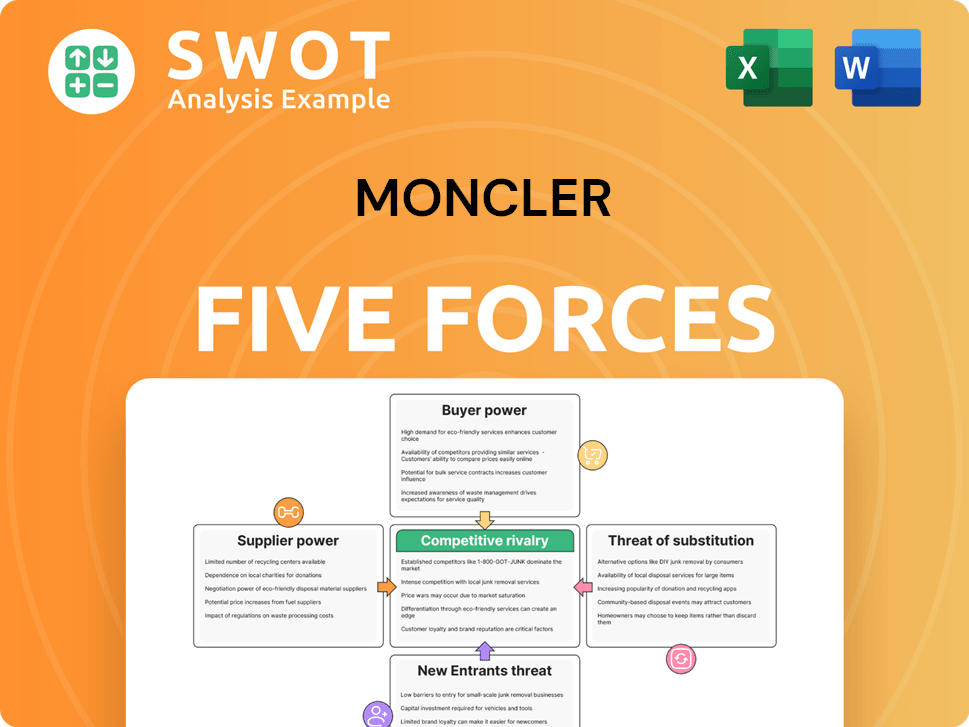
Related Blogs
- What are Mission Vision & Core Values of Moncler Company?
- What is Growth Strategy and Future Prospects of Moncler Company?
- How Does Moncler Company Work?
- What is Sales and Marketing Strategy of Moncler Company?
- What is Brief History of Moncler Company?
- Who Owns Moncler Company?
- What is Customer Demographics and Target Market of Moncler Company?
Disclaimer
All information, articles, and product details provided on this website are for general informational and educational purposes only. We do not claim any ownership over, nor do we intend to infringe upon, any trademarks, copyrights, logos, brand names, or other intellectual property mentioned or depicted on this site. Such intellectual property remains the property of its respective owners, and any references here are made solely for identification or informational purposes, without implying any affiliation, endorsement, or partnership.
We make no representations or warranties, express or implied, regarding the accuracy, completeness, or suitability of any content or products presented. Nothing on this website should be construed as legal, tax, investment, financial, medical, or other professional advice. In addition, no part of this site—including articles or product references—constitutes a solicitation, recommendation, endorsement, advertisement, or offer to buy or sell any securities, franchises, or other financial instruments, particularly in jurisdictions where such activity would be unlawful.
All content is of a general nature and may not address the specific circumstances of any individual or entity. It is not a substitute for professional advice or services. Any actions you take based on the information provided here are strictly at your own risk. You accept full responsibility for any decisions or outcomes arising from your use of this website and agree to release us from any liability in connection with your use of, or reliance upon, the content or products found herein.